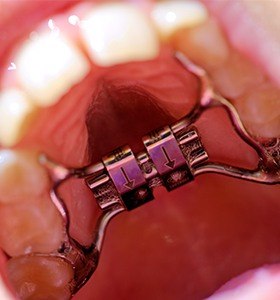
Orthodontic Appliances – Jacksonville, FL
Care That Goes Beyond Braces

Once your braces are removed, the retention phase of your orthodontic treatment will begin. Retention is every bit as important as orthodontics, and this phase generally lasts for 12 months. Wearing your retainer is a crucial part of your orthodontic treatment, so make sure to continue wearing it and not to let your initial investment in time and money go to waste. Be sure to wear your retainer at all times except for when brushing.
Why Choose Ortega Orthodontics for Retainers & Oral Appliances?
- Homegrown orthodontist with years of experience
- Kind, friendly, & highly-skilled team
- All PPO dental insurances accepted
Retainer Basics:

- Retainers should be worn at least 22 hours a day until your doctor tells you differently.
- If your retainer seems tighter than normal when you are putting it in, it is most likely because your teeth are moving. This means you need to wear it more often.
- Take your retainer out for eating and brushing.
- When your retainers are not in your mouth, they should always be in the case! Don’t ever wrap them in a napkin because they will surely be thrown out.
- Always keep your retainers out of reach of pets – especially dogs!
- Many retainers are made with heat, which means they can be distorted if they get hot. Keep your retainers away from hot water, cars and dashboards, pockets, and washing machines.
- Clean your retainer once a day with a toothbrush (no toothpaste) to remove debris. Retainer or denture cleaners can be used as well and are very effective.
- Always bring your retainer to every appointment at Ortega Orthodontics.
- Retainer adjustments should only be made by your orthodontist!
- If you lose or break your retainer, call us immediately. It does not take long for teeth to shift, and the best way to keep your smile straight is through consistent retainer wear.
- Please take care of your retainers, as they are expensive to replace. If properly cared for, they can last for many years.
Different Types of Orthodontic Appliances
Removable Retainers

As we touched on above, retainers help keep newly shifted teeth in place after orthodontic treatment has ended. Otherwise, the teeth would gradually move back into their original positions, and no one wants that to happen! After being advised to wear your retainer as much as possible, you’ll eventually only need to wear it to bed. It’s important to follow Dr. Holland’s instructions so you or your child don’t end up needing to get braces again!
Fixed Retainers

Fixed retainers are cemented into place, and they typically consist of a small metal bar that is placed behind the teeth so that it is hidden from view. This kind of appliance help retained teeth that were severely rotated or misaligned stay straight. Most of the time, they are used on the front teeth, as they are the most likely to stray and become crooked after treatment has ended. We recommend keeping fixed retainers in place for life to prevent the teeth from shifting.
Palatal Expander

Palatal expanders are designed to widen the hard palate of the mouth in order to create more room for the adult teeth. This device is best used on young children before the two bones in the upper jaw have fully fused together. It consists of a small piece of metal that is held within the mouth using 2 loops placed around the upper molars on either side. Using a tiny key, the device is slowly widened in order to guide bone growth.
Thumb Crib

Most children learn to stop sucking their thumb on their own, but others will persist even after their teeth start coming in. This can alter the development of the jaw and even prevent the teeth from erupting correctly, leading a child to need extensive orthodontic treatment. If your child can’t seem to stop, we can place a small device in their mouth called a thumb crib, which physically prevents them from sucking their thumb. After a few weeks, your child should naturally break the habit, and then we can take the crib out.